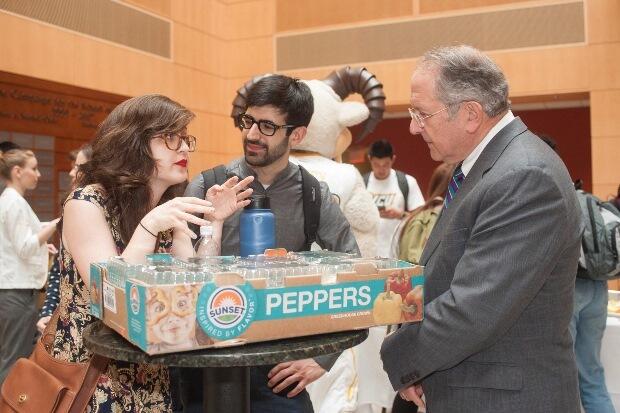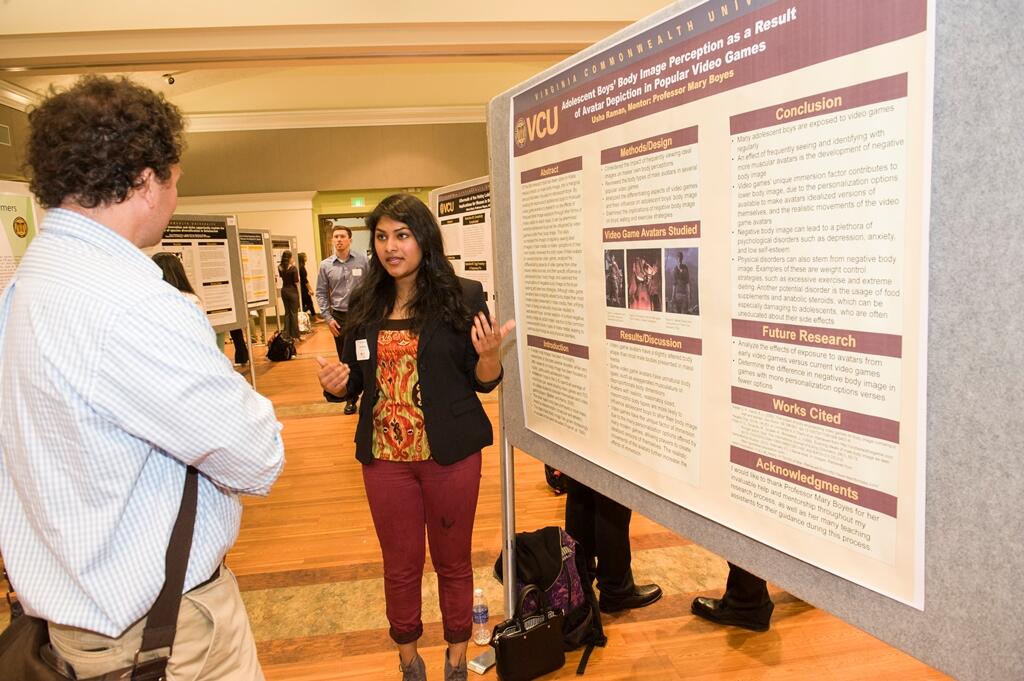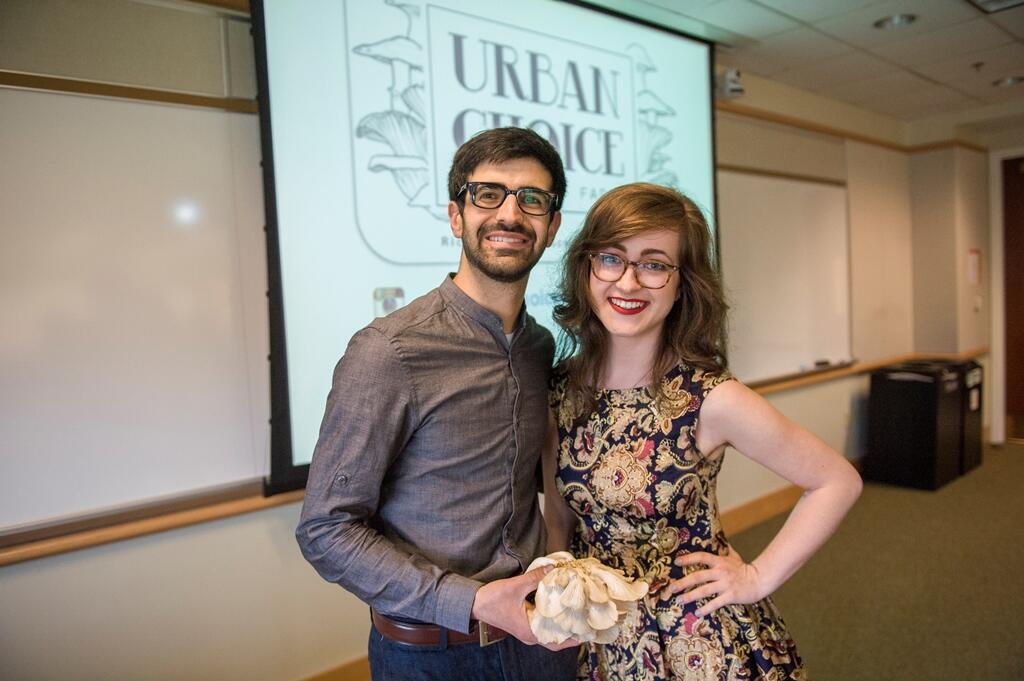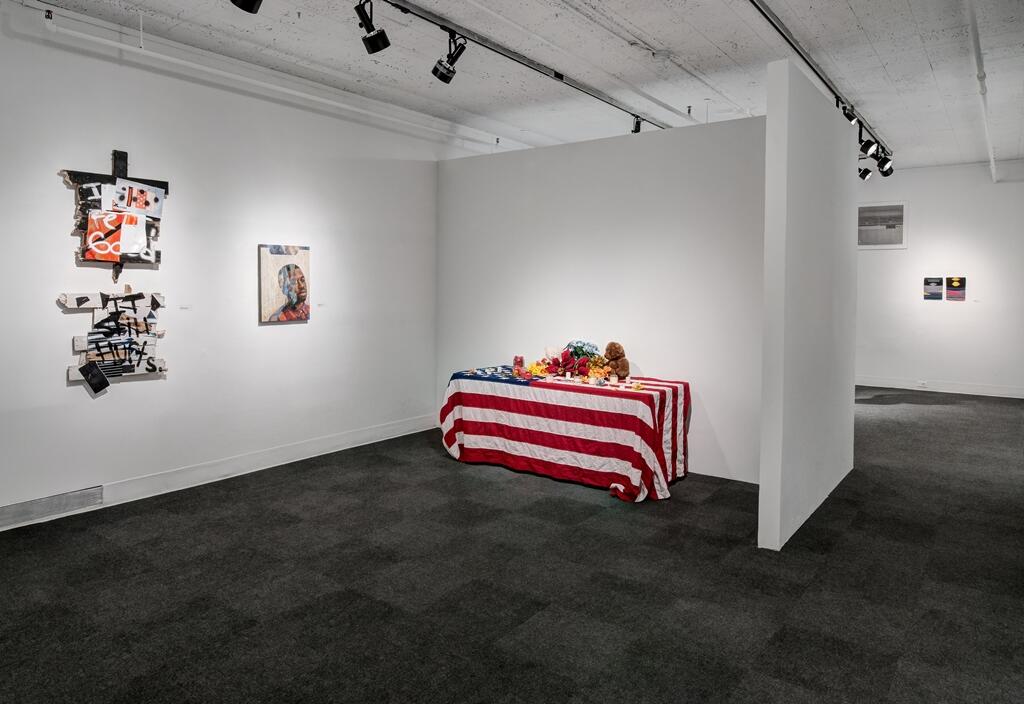
April 30, 2015
Research Weeks 2015
Share this story
Virginia Commonwealth University provost Gail Hackett, Ph.D., knows that research isn’t just for faculty members and doctoral candidates.
Addressing students April 22 at the VCU Symposium for Undergraduate Research and Creativity, Hackett recalled how early forays into research helped determine her career path.
“I was lucky enough to have the opportunity to conduct research as an undergraduate,” she said. “That independent research did have a huge impact on me. It enriched my academic program as a psychology major and influenced my career choice as a researcher and faculty member.”
Organized by the Undergraduate Research Opportunities Program, the symposium allowed undergraduates to share their investigations into everything from 3-D printing to how chemically profiling mixtures with pool chlorine and brake fluid can help authorities solve crimes of arson.
What I see here is not just a room full of posters. What I see is the tangible evidence of what we mean when we talk about student success and academic rigor at VCU.
“What I see here is not just a room full of posters,” Hackett said. “What I see is the tangible evidence of what we mean when we talk about student success and academic rigor at VCU.”
The symposium was one of several events taking place at VCU’s two campuses during Student Research Weeks in April. The annual celebration is a chance for students to present their research, creative and scholarly projects to their peers and the community.
While students have always been active in the university’s research endeavors, Research Weeks has brought to the forefront the sheer amount and diversity of projects being carried out, said Frank Macrina, Ph.D., vice president for research and innovation.
Initially just a week of events, the celebration now stretches across an entire month.
“What we have done is awakened a sleeping giant,” Macrina said.
What follows is a snapshot of some of the projects presented by students this year.
Psychology: Body by avatar

For decades, researchers have studied the impact that magazines and television have on female body image. Usha Raman, a freshmen majoring in biology and psychology, flipped that scenario around by looking at the effect of video game avatars on adolescent boys.
The characters in games today move and look like real humans. They can even be personalized to more closely resemble the tastes and desires of the player.
Raman looked at various avatars. Some were so unnaturally muscular they didn't seem to have much of an impact. Others, such as Nathan Drake from the Unchartered video game series, did.
“The ones that are a little more realistic, the boys start comparing their own bodies to them,” said Raman, who presented her findings at the Symposium for Undergraduate Research and Creativity. “Their realistic and athletic movements caused boys to mimic them. All of this can lead to negative body image and depression and anxiety.”
Raman compared the influence of video games on boys to the effect of other mass media images on adult males. She found that the images of avatars could make boys change their eating and exercise habits, similar to the way other mass media images cause changes in the habits of adult males.
Raman wants to continue her research by looking at how boys react to earlier video games, in which characters were not as muscular and the movements not as realistic.
Political science: Breaches of power?
Moments before they were to address an audience at the 9th Annual Political Science Student Research Conference (April 10), five student researchers huddled with instructor John Aughenbaugh, Ph.D., who would be chairing their panel discussion.
“I know this may be your first time presenting your work and you might be nervous,” he told them during a quick speech meant to both calm nerves and outline protocol.
But by the end of the panel, the first of nearly 30 at the daylong event, the students were engaged in a lively discussion with audience members, who asked questions about everything from privacy rights to the limits, or lack thereof, on executive power.
The five students on Aughenbaugh’s panel presented research on different constitutional conundrums, from whether revenge pornography should be considered free speech to whether Americans targeted by drone strikes deserve due process under the law.
The discussion returned several times to executive power, a topic investigated directly by Rachel Kingery, a sophomore majoring in broadcast journalism and minoring in Spanish and political science.
Kingery looked across the decades at presidential use of executive orders.
Even though executive orders have declined since Franklin Delano Roosevelt, they are often a hot topic in the news media and public today, Kingery said. This could be due to the current climate of intense partisanship and the fact that, while issued less frequently, executive orders have been used for items of greater scope, she said.
Kingery also looked at signing statements, which presidents issue when bills are signed into law. These statements have become controversial in the eyes of critics, who view them as tools to change the meaning of new laws.
The signing statement “is like a line-item veto without calling it that,” Kingery said.
The overuse of signing statements and executive orders can lead to a weakened separation of powers, especially as the Supreme Court continues to sidestep the issue, she said.
“Until a decision is made, the president is in kind of a constitutional gray area,” Kingery said.
All professors want students to express a point of view and take a stand, Aughenbaugh said after the student presentations.
“I really like that all five of you took a stand,” he said.
Business: Mushrooming revenue

Some people look at a mushroom and see a pizza topping, others simply a fungus.
Several students participating in the VCU da Vinci Center-hosted Venture Creation Competition see economic potential for their business ventures.
The winner of this year’s undergraduate competition (April 15), which gives the students the opportunity to pitch their ideas to investors, was a duo operating an urban mushroom farm. Jake Greenbaum, a senior majoring in entrepreneurship in the School of Business, and Lindsay Hawk, a junior majoring in sculpture and extended media in the School of the Arts, received a $4,000 check for their venture called Urban Choice Mushroom Farm, which aims to satisfy a growing demand for fresh, local mushrooms.
Most mushrooms consumed on the East Coast come from a single county in Pennsylvania, and it takes time to harvest mushrooms elsewhere and ship them to homes and restaurants. Urban Choice cuts that distribution time by growing them indoors right here in the city.
Another team, called ViV Design Group, received a check that will help them use fungus as a replacement for roofing tiles made of asphalt, a byproduct of the oil industry.
Asphalt has a short lifespan and harms the environment, said Sarah Poole, a junior majoring in biomedical engineering in the School of Engineering. “It releases carcinogens into the stormwater,” she said.
“We had this eureka moment,” said her business partner Elliot Roth, a senior also majoring in biomedical engineering. “Why can’t we use a naturally grown alternative?”

The pair has been doing test runs with mycelium, the root structure of fungus, in the basement. They take mushrooms, grow them out with algae, sterilize it, bake it and then coat it in a biologically based resin.
The next steps would be to cut it up, package it and ship it to customers such as architecture firms, landscape designers, urban planners and contractors. Of course, they need more funding and a proper laboratory first.
“We’ve been baking it in my oven, and the smell is awful,” Roth said.
Mycelium is flexible and can be as strong as concrete, he said. It is made of chitin, the same material in bug exoskeletons.
“This is the future of building materials,” Roth said.
The idea has caught the attention of local firms eager for a new building product, Poole said.
“We have potential partners who are very excited about this,” she said.
Poole, Roth and two other colleagues plan to spend up to a year more on research and development. If they can corner the asphalt shingle market, they would move on to producing mycelium for roads and sidewalks.
Dentistry: Fear factor

If adults with bad teeth had gone to see third-year School of Dentistry student Shweta Ujaoney when they were children, they might smile more often today.
Ujaoney ran a study that found children were less scared and more accepting of dentists when they are holding syringes that look like toys. She presented her research and findings during the School of Dentistry Clinic and Research Day (April 16).
Ujaoney came up with the idea for a camouflaged syringe after witnessing stressful situations at the dentist in India, where she previously attended school and conducted the study.
“The child would be crying, the parents would be pressuring the child and dentists would be getting frustrated,” she said. “Children see the needle and don’t understand why anyone trying to help them would be doing that to them.”
So Ujaoney made by hand a series of brightly colored acrylic covers that would conceal the needle yet still have a window where dentists could see the amount of anesthetic being delivered. The toy-like covers changed the entire child-parent-dentist dynamic.
“The results were phenomenal,” Ujaoney said.
When approached with the camouflage syringe, children didn’t cry, guard their mouths with their hands or squirm away from the needle, making it easier for the dentist to deliver the anesthetic. When given the choice between a regular syringe and the playful-looking alternative, the children would choose the one that looked like a toy.
As positive reinforcement after the visits, Ujaoney and her team removed the colorful covers from the syringes and let the children take them home.
Art: Imitating life and death

Despite the many scientific inquiries presented by students, Research Weeks began this year in an art gallery.
Dean Daderko, curator of contemporary art at Contemporary Arts Museum Houston, selected a range of student works for the School of Arts Juried Design and Fine Arts Exhibition (March 26-April 5) that kicked off the month's events.
Some of the pieces were designed to do more than make you look.
One, called “Over My Dead Body,” consisted of an American flag draped over a table and covered with a mix of real and fake items and images of six young black men, three of whom were killed by police or, in one case, a member of a neighborhood watch.
There are real and fake candles, fake flowers and teddy bears. Then, there are the faces of the young men, drawn by Malcolm Peacock, creator of the piece and a junior majoring in painting and printmaking.
“It is a piece that was heavily inspired by the recent events of police brutality and racial profiling that have been brought to the forefront of American news and media in the last few years,” Peacock said.
Daderko chose the piece for the “jumping fences” award. Many people have told Peacock that they were moved by his drawings and the words written on them. Under a likeness of Trayvon Martin, it says: “He took my body. But he slaughtered my life. He was a killer. And I was a kid.”
All of the elements of the piece combined can arouse thought and emotion, and the piece takes on added resonance in the dark with the candles lit. Still, it is the handmade drawings that put everything in perspective, Peacock said.
“I spent a significant amount of time studying their faces and their stories through the process of drawing,” he said. “If I didn't have this ability to draw or create these images, then I don't know if I would have been able to share their stories and let them live. And that was the most important thing — to share their stories and let them live.”
Global health: Around the world and back home
The work of VCU student researchers stretches from Richmond to other parts of the globe.
During the VCU Global Health Showcase (April 20), students discussed a variety of issues around the world and what they are doing about them through poster presentations and breakout discussions.
During one discussion, Sean McKenna, M.D., assistant professor in the Division of General Pediatrics at the Children’s Hospital of Richmond, and Michael Stevens, M.D., assistant professor in the Division of Infectious Diseases at VCU Medical Center, gave students advice on how to become and stay involved in global health issues.
They don’t always need to stray far from home to get involved, the professors noted.
“Global health is local health,” McKenna said, pointing to the impact of moving populations and epidemics such as the Ebola outbreak. “And anyone can get involved.”
Students talked about projects in South America, Central America, Africa and Asia. They suggested organizations to work with and discussed ways to secure funding for trips, such as the one third-year School of Medicine student Phil Chapman took to Rwanda to study wait times in a busy trauma center.
“In the United States, if you have a bone sticking out of your leg, you’re going to get surgery to have it fixed fairly quickly,” Chapman said. “What we saw in Rwanda was that patients were waiting an average of two to four days in cases like this.”
One of the reasons for the long waits, Chapman found, was the limited availability of operating rooms. While the initial focus was to study how long patients were waiting and why, Chapman also began looking at what kind of treatment they ultimately received.
He discovered that, even after waiting long periods of time, patients weren’t always receiving appropriate treatments. In some cases, they were given less than what they needed — a splint instead of a cast, for example.
Such a variation could lead to lifelong problems such as a limp, Chapman said.
Research Weeks also included the 11th Annual Women’s Health Research Day (April 2), sponsored by the VCU Institute for Women’s Health and focused on issues that impact college women.
More than 100 people turned out to see 34 posters presentations and participate in discussions on a variety of topics, including caffeine and energy drink consumption, binge eating and violence between partners on college campuses.
World studies: Stayin’ alive
More than 6,000 languages are spoken around the world, and half of them are in danger of becoming extinct.
Language is something that we use to pass down our cultures from generation to generation. You don't just lose a language, you lose the stories, the songs, the significance of cultural practices and a sense of belonging.
“Every 14 days a language disappears,” Tereza McInnes, a senior majoring in international studies, with a concentration in international social justice studies, and French, said at the School of World Studies Senior Research Symposium (April 20).
McInnes researched efforts to revitalize one of these endangered languages, Breton.
A Celtic language brought to France from Britain in the early Middle Ages, Breton has seen a sharp decline in its use compounded by a 1994 constitutional amendment making French the national language.
Mega-languages such as English, French and Chinese can dominate languages with fewer speakers, McInnes said. Smaller tongues die out when the few have to adapt and speak the language of the majority, she said.
“Language is something that we use to pass down our cultures from generation to generation,” she said. “You don't just lose a language, you lose the stories, the songs, the significance of cultural practices and a sense of belonging.”
McInnes sees hope for Breton, though. Thanks to immersion classes, more than 60 percent of students of the Brittany region of France are being taught Breton in school.
The push to keep Breton alive holds lessons for everyone, she said.
“We have to understand how important these little, small, baby languages are because they really do help add color into our lives,” she said.
A strong, focused education and a sense of pride for those that came before can make a difference for more than just those keeping Breton alive, McInnes said.
“And there are cognitive benefits of bilingualism,” she said. “If you know a second language, then learning a third language is even easier.”
Engineering: Troubleshooting technicians

It makes sense that cars are being outfitted with software that can make them brake when detecting objects such as a deer or a vehicle in a blind spot. But the systems themselves don’t always make sense to mechanics with no background in electrical engineering.
When these systems fail, there is a dearth of technicians who are familiar enough with them to fix them.
That’s a problem one group of students aims to solve with a prototype system presented at the School of Engineering Capstone Design Expo (April 24) at the Science Museum of Virginia.
“As more and more systems like this are integrated into cars, technicians need to know more electrical engineering,” said Lucas Cerully, a senior majoring in electrical engineering. “It’s not just radio anymore or heating and cooling, it’s things that potentially could save people’s lives.”
Cerully and his team created a simulator to help train automotive technicians in the troubleshooting of object detection systems. Integrated into the skeleton frame of a car, the system has a front-facing camera and sensors for blind-spot detection. Green, yellow and red LED lights indicate when an object is detected and simulate the automatic braking mechanism that would be triggered as a result.
The team outfitted the simulator with bugs and defects so that schools such as J. Sargeant Reynolds Community College, which sponsored their work, can use it in technician classes.
As the detection systems become more accessible and affordable, the training to fix them should stay in step, said Salima Fenaoui, also a senior majoring in electrical engineering.
“It’s a really great feature for mechanic shops as well, because it can be applied to many different things,” she said. “We’ve made it so anyone — even an 8-year-old — can understand how it works.”
The simulator will reduce costs and waste and help make the most of tools available to the automotive industry, Cerully said.
Someone unfamiliar with the systems may overlook simple causes of malfunctions.
“You might take it to a mechanic and end up paying to replace the whole thing when really all it was is this,” said Cerully, holding up a loose wire before plugging it back into place.
Forensic science: A new solution
The Graduate Student Research Symposium (April 21) gave master’s and doctoral candidates the chance to share a wide range of research, and the examples ranged from an analysis of gender violence in the films of Tyler Perry to the benefits of being patient.
Some students, such as Cherrelle Dugger, are conducting unique enough studies that they stood alone in representing their departments.
A second-year graduate student in forensic chemistry, Dugger looked at a new way to analyze the levels of lamotrigine — a drug increasingly prescribed for seizure and mood disorders — in blood, urine and solid tissues of those who have died.
Instead of the basic liquid-liquid extraction technique used widely in labs, Dugger employed a comparatively rare method called supported liquid extraction to prepare her samples. Among other benefits, the new technique doesn’t require the manual shaking of vials to mix a sample and solvent. Based on Dugger’s study, the new method also saves time.
“It took about three hours to do it the normal way,” she said. “We were able to do it in half the time with an entirely new method. And we eliminated human error.”
The more efficient, accurate method might interest coroners and chief medical examiners in states like Maryland, where officials have reported an increase in cases of lamotrigine toxcity.
In addition to increased speed and ease, Dugger found that the new method also had no trouble withstanding analysis of postmortem and decomposed fluids and tissues.
Social work: Parental guidance
When Kristine Nicole Vassar began her research on grief and loss in the foster care system, the senior in the School of Social Work found plenty of literature on children.
Missing in all that she read was how much foster parents knew and understood about the impact of grief and loss on children in the system, Vassar said at the School of Social Work Research Symposium (April 24).
According to statistics, more than 255,000 children enter the foster care system each year. They often come from situations where they suffered abuse and neglect, but they still experience feelings of loss when taken from their homes, Vassar said.
“They begin to experience a multitude of losses — parents, siblings, friends in schools. Also culture, religion, heritage and their identity,” she said. “Children react to loss with uncertainty, confusion, distress, anxiety and depression.”
So Vassar embarked on an exploratory study meant to fill a gap in the literature.
She conducted a survey through the mail, collecting demographic information and answers to true and false questions. She received responses from foster parents ages 30 to 76 with an average of six years in the system.
Vassar found that in some cases the longer respondents had been foster parents the more knowledge they possessed about grief and loss.
More importantly, though, she discovered a need for more training in regards to grief and loss that could help case managers and foster parents in areas such as skill building and behavior modeling.
In addition to the various schools and departments listed above, sponsors for this year’s Research Weeks events included the Global Education Office, Graduate Student Association and National Scholarship Office.
Feature image at top: Junior Lindsay Hawk and senior Jake Greenbaum discuss their business, Urban Choice Mushroom Farm, with VCU Vice President of Research and Innovation Frank Macrina, Ph.D. The duo’s venture won the top prize in the undergraduate category at the Venture Creation Competition. Photo by Lindy Rodman, University Marketing.
Subscribe for free to the weekly VCU News email newsletter at http://newsletter.news.vcu.edu/ and receive a selection of stories, videos, photos, news clips and event listings in your inbox every Thursday. VCU students, faculty and staff automatically receive the newsletter. To learn more about research taking place at VCU, subscribe to its research blog, Across the Spectrum at http://www.spectrum.vcu.edu/
Subscribe to VCU News
Subscribe to VCU News at newsletter.vcu.edu and receive a selection of stories, videos, photos, news clips and event listings in your inbox.






